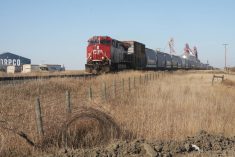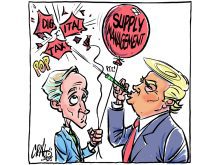Story did dairy farmers a disservice
Re: page 29 story in the Oct. 24 issue of the Western Producer.
Before copy and pasting libellous statements denigrating Canada’s dairy industry, perhaps the Western Producer should actually try some original reporting and investigation.
Read Also

Agriculture needs to prepare for government spending cuts
As government makes necessary cuts to spending, what can be reduced or restructured in the budgets for agriculture?
It is not a fact that “6.8 billion litres of milk have been discarded since 2012”, yet your reporter/publication has presented this as hard truth.
This is a purposefully large, “shock” number derived from a non peer-reviewed paper using assumptions and guesses. No actual data from the dairy industry was collected.
Dalhousie University professor Sylvain Charlebois produced a sham piece of tripe meant to directly smear the Canadian dairy industry and to pump up his reputation.
I am used to other media blindly regurgitating this regular bull plop, and the Western Producer had a chance to present a balanced report. You did not. In fact, your reporter literally copy and pasted the story line from every other publication that wrote on this matter.
Here’s an idea. Have you thought of actually speaking to western dairy farmers to see what they have to say about the amount and nature of their experience with discarded milk? You know, actually make some phone calls instead of taking everything at face value from a slanted press release?
From my dairy experience and listening to dairy representatives, Charlebois is nowhere close with his estimates. Yet all your reporter parroted was the tired old diatribes of food waste and CO2 emissions.
It is said that 215,000 Canadians are employed directly and indirectly by the dairy industry. As an advocate for agriculture, you are doing a poor job for those hard working people.
Blair Gilmore,
Kelwood, Man.
Editor’s note: The Western Producer contacted Dairy Farmers of Canada to talk about the report in question, and it responded with a statement that was included in the story.
Solve Lake Winnipeg’s problems at the source
Lake Superior is known for its pristine waters, but a combination of nutrient additions from increasing human activity, including farming and development, warming temperatures and stormy conditions have resulted in more frequent blooms of potentially harmful algae.
Lately, there has also been a lot of attention focused on the condition of Lake Winnipeg and its algae bloom problems.
With the exception of singling out and reprimanding the City of Winnipeg for it’s raw sewage contributions, I fail to see any successful outcome from committing money to removing the algae blooms.
There is a huge amount of phosphorus stored in farmland and being generated in southeastern Manitoba. That fact cannot be ignored. The potential for blooms comes from nutrient pollution, created from an over-abundance of nitrogen and phosphorus. When nutrient concentrations increase in a body of water like Lake Winnipeg — and with the right combinations of temperature, sunlight and low water flow — algal blooms are triggered and flourish.
Governments would be better to commit money to treat the source of the nutrient problem and change the present regulations to better control the application of phosphorus, rather than just treat algae bloom symptoms.
However, because of governments’ commitment to support economic priorities and expansion of industrial agriculture, especially hog operations, they only focus on treating the symptoms and ignore the actual causes.
With such an approach, Lake Winnipeg doesn’t have a chance of survival.
It’s time for serious political action on phosphorus. You can’t keep feeding the algae blooms and expect a recovery for Lake Winnipeg. Concrete action would be to cap the amount of phosphorus that can be applied to farmland.
The current rules begin to regulate it at 60 p.p.m., five times more than needed for the average cereal crop grown in Manitoba. That, dear readers, is a licence to pollute.
John Fefchak,
Virden, Man.
















